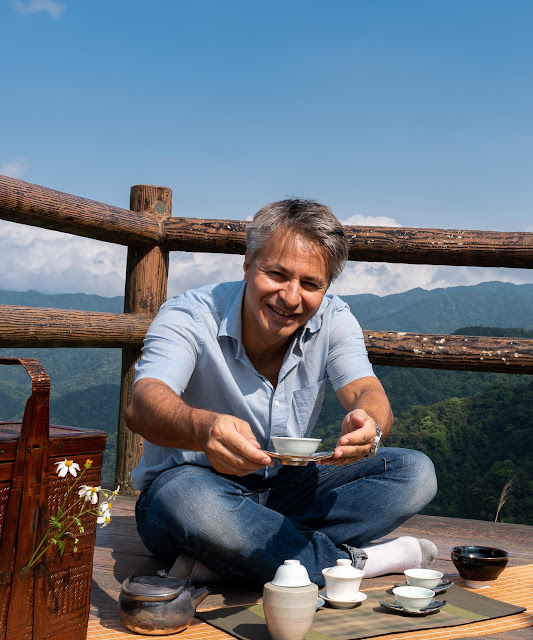La majorité des plantations de Shan Lin Xi sont situées dans la section Yang Keng, à une altitude de 1300 mètres environ. (L'autre section importante, la plus haute, est LongFeng Xia). En semaine, lorsque le traffic est normal, il suffit d'une demi-heure pour rouler de Lugu (Dong Ding) à ces plantations de haute montagne. On y retrouve alors le climat qui régnait à Dong Ding il y a 40 ans: soleil le matin et brouillard l'après-midi. Ces conditions météorologiques étaient l'une des raisons de la qualité supérieure des Oolongs de Dong Ding. Maintenant, on les trouve surtout en haute montagne et, comme le montrent mes photos, à Shan Lin Xi.
Mon fermier a bien voulu me conduire à sa plantation pour me montrer les conditions dans lesquelles poussent son Qingxin Oolong. Cette photo ci-dessus donne une bonne idée de la raideur de la pente dans la plantation. C'est un exercice physique intense de marcher jusqu'au sommet! Mais avec ce brouillard, il n'est pas aisé d'admirer le paysage. J'en profite donc pour remarquer que des larges bambous poussent dans la plantation. Le fermier m'explique qu'il les coupe ou les déterre manuellement, car il n'utilise pas d'herbicides.
J'ai rencontré ce fermier l'an passé et il venait de réduire la taille de ses théiers. En lui parlant, j'ai pu constater sa passion pour le thé et pour sa plantation qu'il chouchoute!
Durant ma visite de sa plantation, il me montrait avec une certaine fierté ses théiers, le lendemain de la cueillette. "Regarde tous ces bourgeons que les cueilleuses ont laissé sur les théièrs. Je leur ai demandé de ne pas faire une récolte trop intensive, afin de ne pas fatiguer les arbres et le sol. De plus, je ne ferai pas de récolte en été, mais juste une autre en hiver. Avec seulement 2 récoltes par an, mes arbres sont en meilleure forme et nécessitent moins d'engrais (naturels)."
Il me dit aussi utiliser peu d'insecticide (sauf quand c'est absolument nécessaire), et il me montre alors ce petit criquet vert dans l'arbre à nos pieds. C'est le même insecte qu'on retrouve à Hsin Chu et qui est essentiel dans la production de la Beauté Orientale! C'est la preuve qu'il minimise bien les produits phyto-sanitaires et qu'il pourrait presque faire du Concubine Oolong (mais ce n'est pas le cas).
Ci-dessus, il me montre ce fil de plastique qui fait office de clôture avec la plantation voisine (à droite). Cette plantation-ci n'a pas encore été récoltée. Cela montre que la plantation de mon fermier a été récoltée relativement tôt, et c'est pourquoi ses feuilles sont si tendres et concentrées!
Les deux prochaines photos furent prises à 20 minutes d'intervalle. Elles montrent bien comment le brouillard peut rapidement laisser place au soleil en fin d'aprè-midi!
Le panorama se dégage, les couleurs resplendissent:
Un groupe d'une bonne vingtaine de cueilleuses a récolté les feuilles de cette plantation le 2 et le 3 mai 2020. Et comme j'ai bien aimé les deux productions de ces deux jours, je les ai sélectionnées ce printemps pour vous permettre de constater combien le Oolong de haute montagne est subtil. Il n'y a qu'un jour de différence, et la plantation est la même, mais on ressent bien la différence entre un Oolong du 2 mai puissant et un Oolong du 3 mai plus en finesse. Et c'est cela que j'aime le plus: le goût très pur et harmonieux d'un même jour de récolte (pas un mix de plusieurs jours).
Ce qui est aussi intéressant avec Shan Lin Xi, c'est la proximité avec Dong Ding. Comme dit, en 30 minutes on est de retour dans ce centre de la torréfaction à Taiwan! Et il n'est pas étonnant que certains s'amusent aussi à torréfier ces feuilles de haute montagne! En effet, ce qui fait la complexité du Oolong, c'est que non seulement on peut varier son degré d'oxydation, mais qu'on peut aussi varier son degré de torréfaction!
De la même plantation, j'ai aussi ramené deux Oolongs torréfiés à des niveaux différents. D'abord, un Oolong légèrement torréfié dont la couleur de l'infusion ne varie guère, mais qui est séché en profondeur. C'est la première étape de la torréfaction. Mais j'ai surtout sélectionné ce top Hong Shui dont la torréfaction correspond bien à la méthode de la compétition de Dong Ding appliquée à un Oolong de haute montagne:
Avec ce Hong Shui Oolong, on côtoie les meilleurs Oolongs de la compétition de Lugu! L'infusion a franchement changé de couleur. Elle brille, châtoie et étincelle comme de l'or liquide au soleil! Et que le goût est profond, gouleyant, long en bouche avec ces notes de fraicheur et de malt!
La torréfaction de maitre a su préserver les arômes les plus fins, et a sublimé l'énergie de Shan Lin Xi. Il convient si bien à la préparation dans une petite théière zisha d'Yixing!...
Bref, grâce à ces 5 Oolongs de Shan Lin Xi, nous avons pu explorer les changements subtils de la haute montagne, et les changements plus radicaux dus à la torréfaction!
2024 vs 2023 Tea Encounter YiShanMo Gushus!
3 hours ago









































